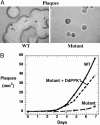Inorganic polyphosphate in Dictyostelium discoideum: influence on development, sporulation, and predation
- PMID: 15701689
- PMCID: PMC549442
- DOI: 10.1073/pnas.0500023102
Inorganic polyphosphate in Dictyostelium discoideum: influence on development, sporulation, and predation
Abstract
Dictyostelium discoideum, a social slime mold that forms fruiting bodies with spores, depends on inorganic polyphosphate (poly P) for its cycles of development and for nutritional predation on bacteria. The synthesis of poly P, a polymer of tens or hundreds of phosphate residues linked by high energy, ATP-like bonds, is catalyzed in most bacteria by poly P kinase (PPK1). The eukaryote D. discoideum possesses a homolog of PPK1. We report here that mutants of D. discoideum PPK1 (DdPPK1) have reduced levels of poly P and are deficient in development. Fruiting bodies are smaller and produce fewer spores, which appear to germinate like the wild type (WT). The DdPPK1 mutant formed smaller plaques on bacterial lawns compared with those of the WT. Predation by D. discoideum, assessed by uptake and digestion of Klebsiella aerogenes, showed that fewer bacteria were taken up by the DdPPK1 mutant compared with the WT and were killed less rapidly, indicating a role of poly P and/or DdPPK1 in phagocytosis. On Pseudomonas aeruginosa lawns, cleared plaques were observed with the bacterial PPK1 mutant but not with the WT P. aeruginosa. Thus, poly P is important in predation both for the predator and prey.
Figures






Similar articles
-
Inorganic polyphosphate in the origin and survival of species.Proc Natl Acad Sci U S A. 2004 Nov 16;101(46):16085-7. doi: 10.1073/pnas.0406909101. Epub 2004 Nov 1. Proc Natl Acad Sci U S A. 2004. PMID: 15520374 Free PMC article. Review.
-
Formation of an actin-like filament concurrent with the enzymatic synthesis of inorganic polyphosphate.Proc Natl Acad Sci U S A. 2004 Nov 9;101(45):15876-80. doi: 10.1073/pnas.0406923101. Epub 2004 Oct 20. Proc Natl Acad Sci U S A. 2004. PMID: 15496465 Free PMC article.
-
Polyphosphate kinase 1, a conserved bacterial enzyme, in a eukaryote, Dictyostelium discoideum, with a role in cytokinesis.Proc Natl Acad Sci U S A. 2007 Oct 16;104(42):16486-91. doi: 10.1073/pnas.0706847104. Epub 2007 Oct 10. Proc Natl Acad Sci U S A. 2007. PMID: 17940044 Free PMC article.
-
Eukaryote polyphosphate kinases: is the 'Kornberg' complex ubiquitous?Trends Biochem Sci. 2008 Dec;33(12):577-82. doi: 10.1016/j.tibs.2008.09.007. Epub 2008 Oct 18. Trends Biochem Sci. 2008. PMID: 18938082
-
Inorganic polyphosphate: essential for growth and survival.Annu Rev Biochem. 2009;78:605-47. doi: 10.1146/annurev.biochem.77.083007.093039. Annu Rev Biochem. 2009. PMID: 19344251 Review.
Cited by
-
Systematic screening of polyphosphate (poly P) levels in yeast mutant cells reveals strong interdependence with primary metabolism.Genome Biol. 2006;7(11):R109. doi: 10.1186/gb-2006-7-11-r109. Genome Biol. 2006. PMID: 17107617 Free PMC article.
-
A Heat Shock Protein 48 (HSP48) Biomolecular Condensate Is Induced during Dictyostelium discoideum Development.mSphere. 2019 Jun 19;4(3):e00314-19. doi: 10.1128/mSphere.00314-19. mSphere. 2019. PMID: 31217303 Free PMC article.
-
Inorganic polyphosphate in mammals: where's Wally?Biochem Soc Trans. 2020 Feb 28;48(1):95-101. doi: 10.1042/BST20190328. Biochem Soc Trans. 2020. PMID: 32049314 Free PMC article. Review.
-
Two endogenous Dictyostelium discoideum chemorepellents use different mechanisms to induce repulsion.Proc Natl Acad Sci U S A. 2025 Jun 3;122(22):e2503168122. doi: 10.1073/pnas.2503168122. Epub 2025 May 27. Proc Natl Acad Sci U S A. 2025. PMID: 40424125
-
Polyphosphate: an ancient molecule that links platelets, coagulation, and inflammation.Blood. 2012 Jun 21;119(25):5972-9. doi: 10.1182/blood-2012-03-306605. Epub 2012 Apr 19. Blood. 2012. PMID: 22517894 Free PMC article. Review.
References
-
- Kornberg, A., Rao, N. N. & Ault-Riché, D. (1999) Annu. Rev. Biochem. 68, 89–125. - PubMed
Publication types
MeSH terms
Substances
LinkOut - more resources
Full Text Sources
Other Literature Sources
Molecular Biology Databases

